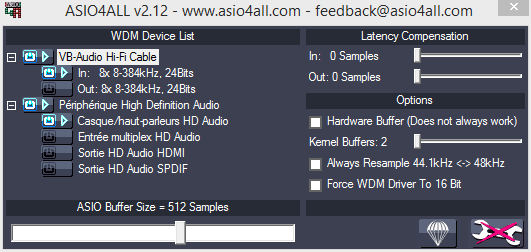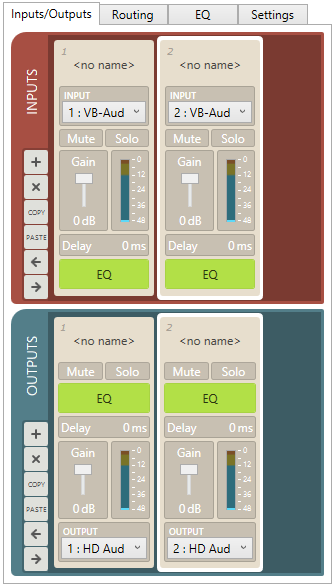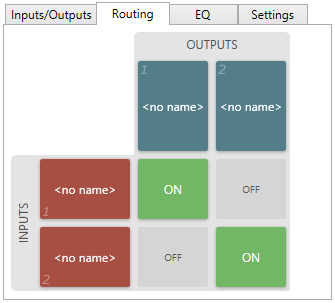
Using EKIO with ASIO4ALL
This tutorial describes how to use EKIO to filter the audio emitted by Windows applications and play the result through ASIO4ALL to a non-ASIO sound card.
You only need to perform this procedure once, as the settings will be saved for future use.
- Start by installing the following software:
- Run EKIO and create a new config by clicking the File/New menu.
- In the "Settings" tab, select the ASIO4ALL driver.
- Open the ASIO4ALL configuration window by clicking its icon in the system tray :

- Click the spanner located in the lower right of the window to activate the "Advanced Options."
-
Select the VB-Audio Hi-Fi Cable ➜ In, and select your sound card’s outputs.
Uncheck all other lines. Do NOT select VB-Audio Hi-Fi Cable ➜ Out.

- To apply the changes, disconnect EKIO from the ASIO4ALL driver. To do this, go to the Settings tab, select the NONE driver, then select ASIO4ALL again. The changes are now applied.
-
Within EKIO, go to the Inputs/Outputs tab. Create, for example, two inputs and two outputs, and connect them together in the Routing tab.
In the Inputs/Outputs tab, select the input channels "VB-Hi-Fi Audio Cable 1" and "VB-Audio Hi-Fi Cable 2". Select output channels 1 and 2.


-
Now, start audio processing by clicking the playback button. You can save the config if you want to be able to load it again later.

-
To route all Windows applications through EKIO, right-click the Windows volume level icon in the system tray, click Playback Devices, right-click "CABLE Input" listed, and choose Set as Default Audio Device.
To route a specific application through EKIO, go to the application's preferences and choose "CABLE Input" as the output device.
Note
In our example, the input channels are forwarded directly to the output channels without modification. This is not very useful.
Configure EKIO to execute the processing you want. Create the necessary inputs and outputs. Connect them. Set the filters, gains, and delays you want to apply.
For an in-depth description of EKIO, refer to the user manual.